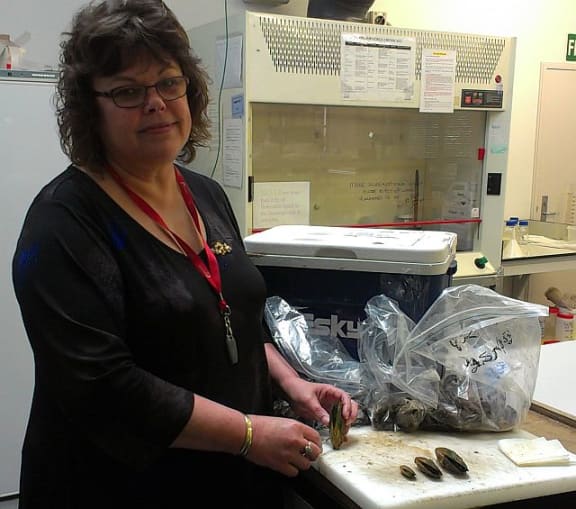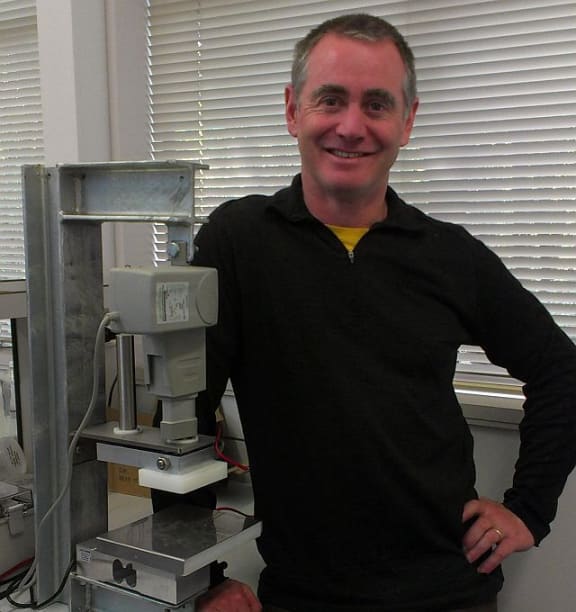
NIWA staff analyse three different sizes of mussels from around New Zealand. Each mussel is weighed and measured before it is tested. Photo: RNZ / Katy Gosset
They call it the Mussel Crusher. But the machine designed by staff at the National Institute of Water and Atmospheric Research actually does much more. By applying and then measuring pressure to the shell, it may give mussel farmers a useful insight into the condition of different shellfish around the country.

Jeanie Stenton-Dozey is an aquaculture scientist with NIWA. Photo: RNZ / Katy Gosset
NIWA scientist, Dr Jeanie Stenton-Dozey, says frozen mussel samples come to the team every two months from three locations: the Firth of Thames, the Marlborough Sounds and Big Glory Bay on Stewart Island. The samples are in three sizes: “babies”, full grown mussels and what Dr Stenton-Dozey likes to call “the teenagers”. But she says shell strength is just one of numerous measurements taken in a bid to better understand the environmental factors that affect mussel growth. Other data include the length, height and weight of the shells as well as the mussel body condition and the state of the reproductive organs.
“Over time we can see seasonally how the mussel condition changes, and we can see that spatially through New Zealand from the North all the way to the South.”
Industry Driven Research
Jeanie Stenton-Dozey says the three year project was prompted by a bad season for mussels in the Firth of Thames in 2011. She believes environmental factors were the predominant reason for the poor mussel condition.
“So, what we’re trying to do in this project is find that link between mussel condition and environmental variability.” She says the study is funded by a core research grant from the Ministry for Primary Industries and is aimed at helping the aquaculture industry. Dr Stenton-Dozey says much of her core-funded work is applied research that needs to tackle issues of concern to mussel farmers.
“We have to use the funds so that industry can grow and become more efficient and benefit from the research we are doing.”
The Right Mussels for the Job

NIWA mechanical engineer Brendan Smith helped design the Mussel Crusher. Photo: RNZ / Katy Gosset
Jeanie Stenton-Dozey says the information collected should help farmers make better decisions about how to process their mussels and, in particular, to decide the right use for different mussels. She says part of what she is looking at in the body tissue are biochemical elements such as fatty acid and amino acid profiles. These could show that particular mussels would be suitable for use in the nutraceutical industry.
“Most of that is for putting into capsules for human consumption for treating arthritis. It’s also used even in dog medication these days and it’s seen to have many health benefits.”
She says if the study succeeds in finding a relationship between mussel condition and environmental variability, the scientists will have established a predictive tool.
“To be able to let the farmers know that 'Look, the conditions are possibly deteriorating. You might need to consider other markets for your products other than human consumption because the mussels won’t have so much flesh in them'”. She says that will enable farmers to better manage their stocks.
Aided by El Nino
Dr Stenton-Dozey says she expects that the El Nino climate conditions predicted this year may have an impact on the study. She says changes in water temperature have an influence on phytoplankton production which is the food of mussels and that will therefore influence the mussels themselves. She thinks this may result in an environmental condition that shows up in the data.
“If this El Nino is as severe as they predict, I’m sure we’re going to find something which, in a way, is fortuitous because then we’re getting a very strong environmental signal which only comes every seven years.”
However, she says, if the El Nino effect is not as strong as predicted, the team may have to wait two years to establish any clear links between the state of the mussels and changing environmental conditions.

